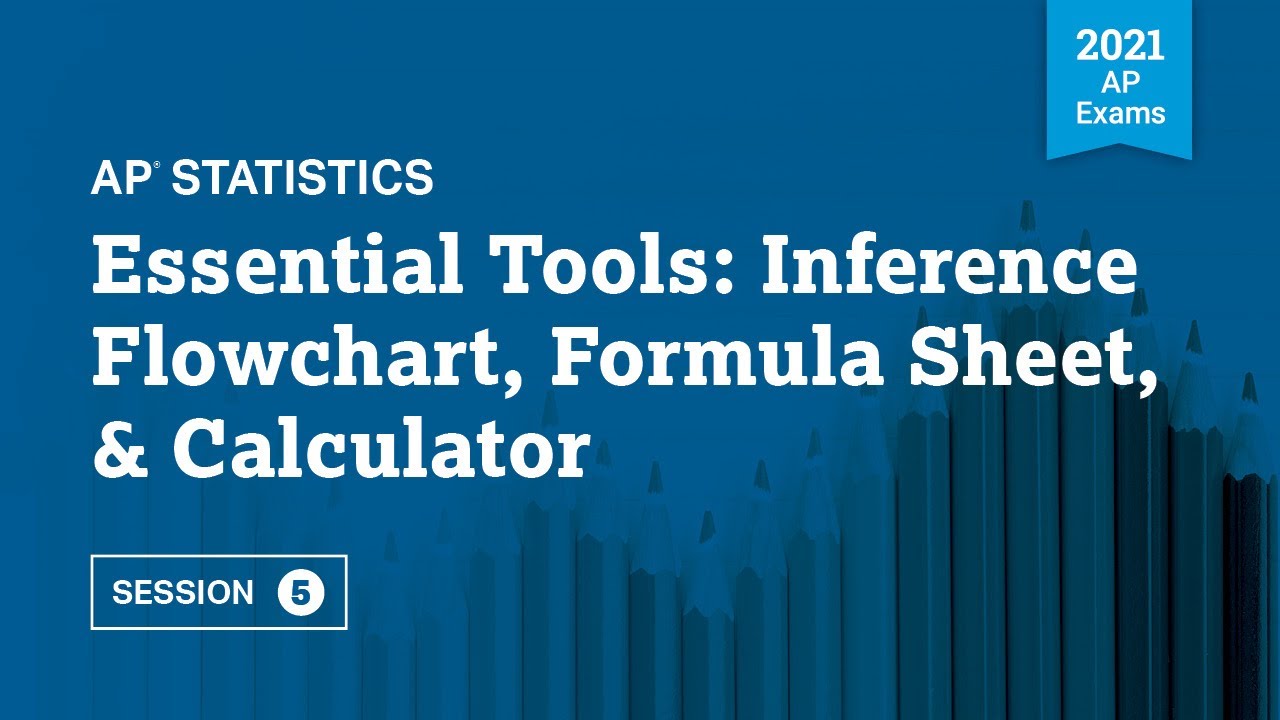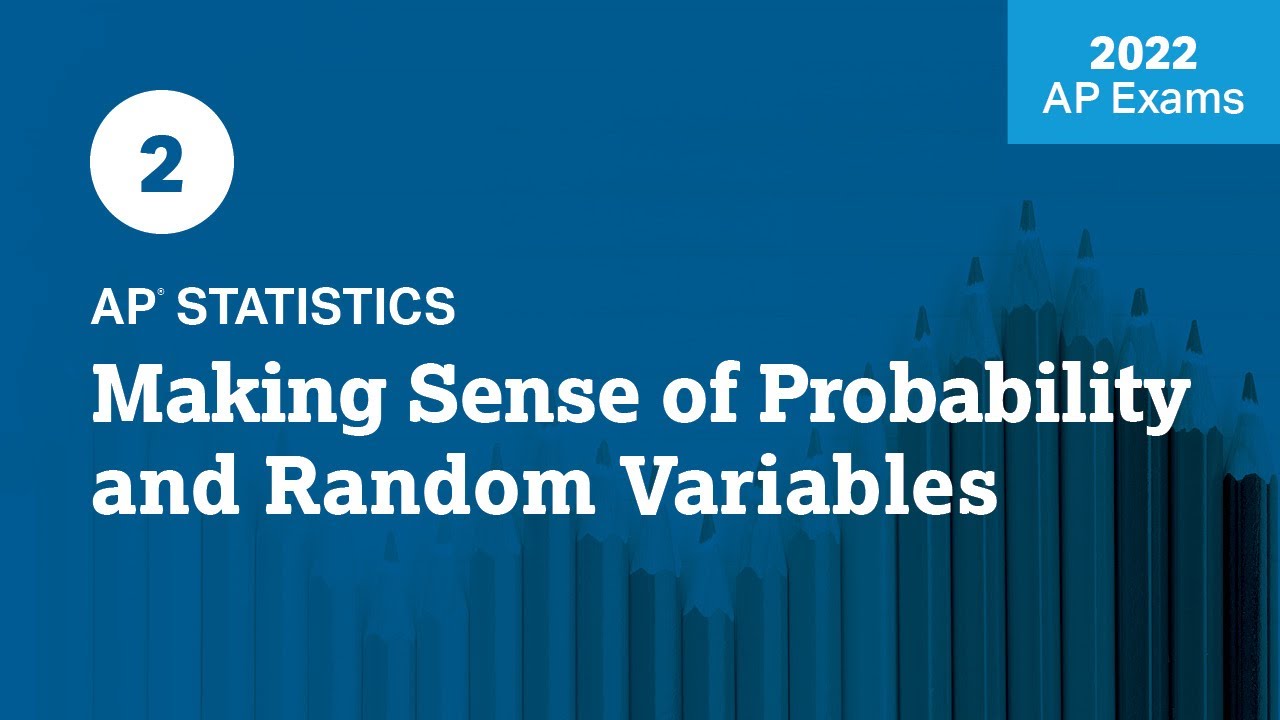2021 Live Review 8 | AP Statistics | Top 10 Tips for Success on the AP Statistics Exam
TLDRIn this comprehensive AP Statistics review session, instructors Darren Starns and Mr. Wilcox provide a finale to their eight-part series. They offer top 10 tips for exam success, covering pacing, scoring, answering strategies, and exam preparation. The session emphasizes the importance of reading questions carefully, using a graphing calculator wisely, and leveraging the formula sheet. The instructors also address common mistakes to avoid and encourage students to practice with previous AP exam questions to identify and strengthen weak areas, boosting confidence for the upcoming exam.
Takeaways
- 📚 The session is a finale of the AP Statistics review series, aiming to provide students with top tips for success on the AP exam.
- 👋 Introductions are made by the hosts, Darren Starns and Mr. Wilcox, who express excitement for the final session and acknowledge the rewarding experience of the project.
- 🔍 A recap of the previous sessions is given, highlighting the focus on challenging content and the development of critical skills for the AP exam.
- 📈 The importance of having a graphing calculator with statistical capabilities during the AP exam is emphasized, as it is an expected tool for students.
- 📝 Students are reminded to utilize the provided handouts and resources, including a formula sheet and tables, to aid in exam preparation.
- ⏰ The session outlines the structure of the AP exam, detailing the number of questions and the time allotted for each section.
- 🎯 Tip one focuses on pacing, advising students to start with questions they feel confident about and to allocate sufficient time for the investigative task.
- 📉 The scoring system for the AP exam is explained, with the multiple-choice section and free response section each accounting for half of the total score.
- 🤓 The hosts stress the importance of reading the question (RTQ) and answering the question (ATQ) carefully to avoid common mistakes made by students on the exam.
- 📑 For the free response section, students are advised to show all work, as they will be scored on the correctness of methods as well as the accuracy and completeness of results and explanations.
- 🚫 A reminder is given that students should not write excessive amounts in their free response answers to avoid statistical errors and unnecessary deductions.
Q & A
What is the main purpose of the 'AP Daily Live Review for AP Statistics' sessions?
-The main purpose of the 'AP Daily Live Review for AP Statistics' sessions is to help students prepare for the AP Statistics exam by focusing on challenging content, developing critical skills, and providing specific strategies for multiple choice and free response questions.
Who are the hosts of the 'AP Daily Live Review for AP Statistics' sessions?
-The hosts of the 'AP Daily Live Review for AP Statistics' sessions are Darren Starns and Mr. Wilcox, who are both experienced in teaching AP Statistics.
What is the significance of the handout provided in the session?
-The handout provided in the session serves as a session aid, which includes important formulas, tables, and possibly a flowchart for inference procedures, to assist students during the review and exam preparation.
Why is a graphing calculator important for the AP Statistics exam?
-A graphing calculator with statistical capabilities is important for the AP Statistics exam because students are expected to have one during the exam, and it can greatly facilitate solving problems related to statistics.
What is the advice given for pacing during the AP Statistics exam?
-The advice given for pacing during the AP Statistics exam is to start with questions you feel confident about, not to spend too long on any one question, and to allocate time for the investigative task, which is suggested to be around 25 minutes.
What is the scoring breakdown for the AP Statistics exam?
-The scoring breakdown for the AP Statistics exam is that the multiple choice section is worth half of the overall score with 50 points, and the free response section is also worth the other half with 50 points. Each question in the free response section has a different multiplier for scoring.
What is the difference between the paper and pencil version and the digital version of the AP Statistics exam?
-The paper and pencil version of the AP Statistics exam consists of 40 multiple choice questions and 6 free response questions. The digital version has 40 multiple choice questions in section 1 and then 11 multiple choice and 4 free response questions in section 2, including an investigative task.
Why is it important to read the question carefully (RTQ) and answer the question that's asked (ATQ) on the AP Statistics exam?
-It is important to read the question carefully (RTQ) and answer the question that's asked (ATQ) to avoid common mistakes such as missing important details or answering a similar question from a previous exam rather than the actual question on the current exam, which can lead to incorrect responses.
What does the acronym 'CUSS' stand for in the context of describing distributions?
-In the context of describing distributions, 'CUSS' stands for Center, Unusual features, Shape, and Spread, which is an alternative to 'SOCK' and is considered more memorable by some students.
What is the advice for answering free response questions in terms of the amount of writing?
-The advice for answering free response questions is to not write too much. The space provided is more than enough, and writing excessively can lead to statistical errors or misuse of terms, which can negatively impact the score.
What are some examples of misused statistical terms that students should be cautious about?
-Some examples of misused statistical terms include 'confounding', 'biased', 'blocking versus stratifying', 'independent', 'correlation versus association', 'sampling distribution', 'sample distribution', and the misuse of the term 'skewed'.
What is the importance of using the correct statistical notation in responses?
-Using the correct statistical notation is crucial because misuse of notation can lead to a mandatory deduction in scoring, just like misusing a vocabulary term. It ensures clarity and accuracy in the communication of statistical concepts.
What is the advice for students when dealing with inference questions on the AP Statistics exam?
-The advice for dealing with inference questions is to know the different inference procedures, practice identifying the correct method from the question, follow the inference process carefully, and use resources like the inference flowchart and comprehensive review applet for practice.
How should students approach using their calculator during the exam?
-Students should use their calculator wisely to save time or avoid potential mistakes. They should ensure it is ready for exam day, use it for probability and inference calculations, and show the correct inputs and calculations when using it for free response questions.
What is the role of the formula sheet during the AP Statistics exam?
-The formula sheet serves as a reference for students during the exam. It includes important formulas for descriptive statistics, probability, and distributions, as well as inference. Students should be familiar with its contents but not rely on memorizing everything as some formulas need to be constructed during the exam.
What is the final advice for students preparing for the AP Statistics exam?
-The final advice is for students to practice multiple choice and free response questions, take full practice exams under timed conditions, identify weak spots, review content and skills using resources like AP Daily videos, and be confident in their abilities after participating in the review sessions.
Outlines
📚 Welcome to the Final AP Stats Review Session
The paragraph introduces the final session of the AP Statistics live review series, hosted by Darren Starns from Princeton, New Jersey. It provides a brief recap of the previous seven sessions, which focused on challenging content and exam strategies. Darren is joined by colleague Mr. Wilcox for the finale. They highlight the importance of the session 8 handout, the formula sheet, and the graphing calculator. They also mention the resources provided based on student feedback and address common questions about the exam, including the use of pen or pencil and the prohibition of the inference flowchart during the exam. The paragraph concludes with a reminder to provide feedback after the session.
🔍 Session 8: Top 10 AP Exam Tips
This paragraph outlines the structure of session eight, which includes the top 10 tips for success on the AP Statistics exam. The tips are categorized into exam pacing and scoring, answering questions effectively, and preparing for exam day. The paragraph emphasizes the importance of pacing oneself during the exam, especially noting the time allocation for multiple-choice and free-response sections. It also provides an overview of the types of free-response questions that will be encountered.
⏱️ Understanding the Scoring System for the AP Exam
The paragraph delves into the scoring system for the AP Statistics exam, explaining the point values for multiple-choice and free-response questions. It details the scoring for each type of question and provides the cut scores needed to achieve different AP exam scores based on the 2019 exam. Additionally, it contrasts the scoring for the paper and pencil exam with the digital exam, highlighting the differences in the free-response section of the digital exam.
📝 The Importance of Reading and Answering Questions Thoroughly
The paragraph stresses the importance of reading questions carefully (RTQ) and answering the questions that are asked (ATQ). It discusses common mistakes made by students, such as not reading the entire question or answering a similar question from a previous exam. Examples are provided to illustrate how to correctly approach questions about data distribution, comparison of distributions, and the relationship between variables. The paragraph advises against guessing at the beginning of the exam and emphasizes the need to address all parts of a question.
🔢 Demonstrating Work for Free Response Questions
This paragraph focuses on the necessity of showing all work for free-response questions, as it is a requirement for scoring. It provides examples of how to demonstrate calculations for probability and regression, emphasizing the need to show the computation process. The paragraph advises against providing only a final answer without showing the work that led to it, as this can result in partial or no credit.
🚫 Avoid Overwriting in Free Response Sections
The paragraph advises students to avoid writing excessively in the free-response section to prevent statistical errors and unnecessary information that might confuse or mislead the graders. It cautions against attempting multiple solutions to the same question, as only the weaker solution will be graded. The paragraph also warns against arguing with the question's assumptions or conditions, as these are integral to the question's context.
📚 Using Statistical Language and Notation Correctly
This paragraph emphasizes the importance of using correct statistical vocabulary and notation to avoid mandatory deductions. It lists commonly misused terms and advises students to ensure they understand the specific meanings before using them. The paragraph also provides examples of correct and incorrect use of notation and stresses the importance of using the right terms and symbols to convey the right concepts.
🧐 Mastering Inference for the AP Statistics Exam
The paragraph discusses the significance of inference in the AP Statistics exam and provides an overview of different inference procedures for categorical and quantitative data. It suggests using resources like the inference flowchart and a comprehensive review applet to practice identifying the correct inference method. The paragraph also advises students to follow a structured process when answering inference questions, both in multiple-choice and free-response formats.
🔧 Utilizing the Calculator Effectively
This paragraph offers advice on using the graphing calculator wisely during the exam. It suggests using the calculator for time-saving and avoiding mistakes, particularly on probability and inference questions. The paragraph also provides guidance on how to show work even when using a calculator, emphasizing the need to identify variables, distributions, and parameters correctly.
📈 Leveraging the Formula Sheet and Tables
The paragraph highlights the importance of the formula sheet and tables provided for the exam. It advises students to familiarize themselves with the content on the formula sheet, which includes descriptive statistics, probability distributions, and inference formulas. The paragraph also reminds students of what is not included on the formula sheet, such as complete formulas for confidence intervals and significance tests, and the need to understand certain mathematical principles.
💪 Final Preparation and Confidence Building
The final paragraph focuses on the remaining preparation time before the AP exam. It encourages students to practice multiple-choice and free-response questions, especially from previous AP exams, and to take full practice exams under timed conditions. The paragraph advises students to identify weak spots and strengthen them using resources like AP Daily videos, AP Central, and Khan Academy. It concludes with a message of confidence and support for the students, expressing belief in their ability to succeed on the exam.
🎉 Closing Remarks and Encouragement
In the closing paragraph, the hosts express gratitude to the College Board team and the students for participating in the review sessions. They share personal anecdotes and humorous stories from the session preparation and filming process. The paragraph ends with a heartfelt thank you and well-wishes for the students' success on the AP exam, emphasizing the support and confidence in their abilities.
Mindmap
Keywords
💡AP Statistics Exam
💡Pacing
💡Multiple Choice Questions
💡Free Response Questions
💡Inference
💡Descriptive Statistics
💡Probability
💡Scoring
💡Investigative Task
💡Formula Sheet
💡Graphing Calculator
Highlights
Introduction to the final session of AP Statistics live review with hosts Darren Starns and Mr. Wilcox.
Recap of the first four sessions focusing on challenging content and critical skills for the AP exam.
Overview of the last three sessions targeting specific strategies for multiple choice and free response questions.
Emphasis on the importance of having a graphing calculator with statistical capabilities for the AP exam.
Announcement of new resources developed based on student feedback, including an alignment with AP daily videos and an inference procedure flowchart.
Clarification that the inference flowchart cannot be used during the exam, only for preparation.
Discussion on the format and requirements for the free response section of the AP Statistics exam.
Explanation of the scoring system for both multiple choice and free response sections of the exam.
Presentation of the 2021 AP Statistics exam structure, including the unique digital exam format.
Introduction of the top 10 tips for success on the AP Statistics exam, covering pacing, scoring, and exam preparation.
Advice on pacing oneself during the exam, especially focusing on starting with questions one feels confident about.
Importance of reading the question carefully (RTQ) and answering the question that is asked (ATQ) to avoid common mistakes.
Guidance on showing all work for free response questions and the significance of method correctness.
Recommendation against writing too much in the free response section to avoid statistical errors.
Emphasis on using correct statistical vocabulary and notation to avoid mandatory deductions.
Discussion on the various inference procedures for categorical and quantitative data and the importance of identifying the correct method.
Advice on using the graphing calculator wisely during the exam for time-saving and error avoidance.
Encouragement to lean on the formula sheet provided during the exam for descriptive statistics, probability, and inference.
Final tip on preparing for the exam through practice questions, full practice exams, and identifying weak spots for improvement.
Closing remarks expressing confidence in students' abilities and gratitude for their participation in the review sessions.
Transcripts
Browse More Related Video

2022 Live Review 1 | AP Statistics | Making Sense of Collecting and Exploring Data

2022 Live Review 5 | AP Statistics | Vital Resources for the AP Exam: Inference Flowchart

2021 Live Review 1 | AP Statistics | How to Explore and Collect Data

2021 Live Review 5 | AP Statistics | Essential Tools Inference Flowchart, Formula Sheet & Calculator

2022 Live Review 2 | AP Statistics | Making Sense of Probability & Random Variables

2021 Live Review 6 | AP Statistics | Rubrics for Free-Response Success on the AP Statistics Exam
5.0 / 5 (0 votes)
Thanks for rating: